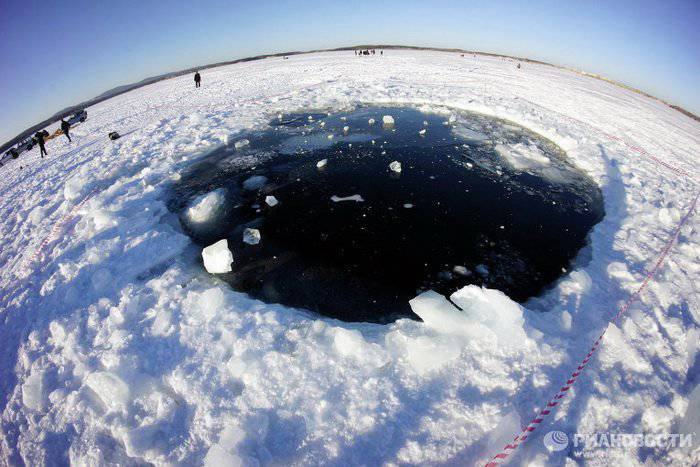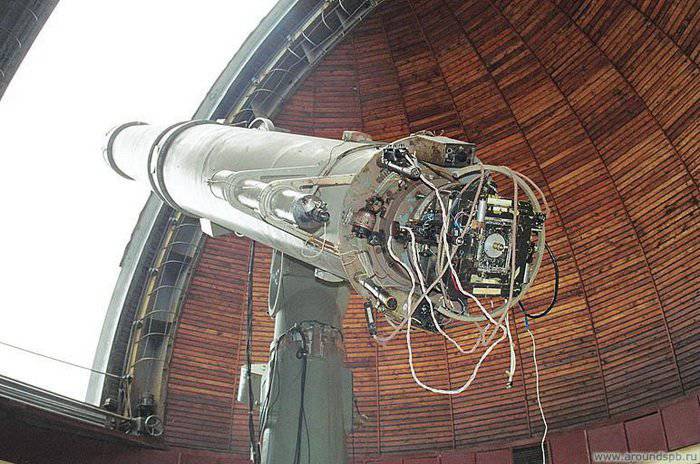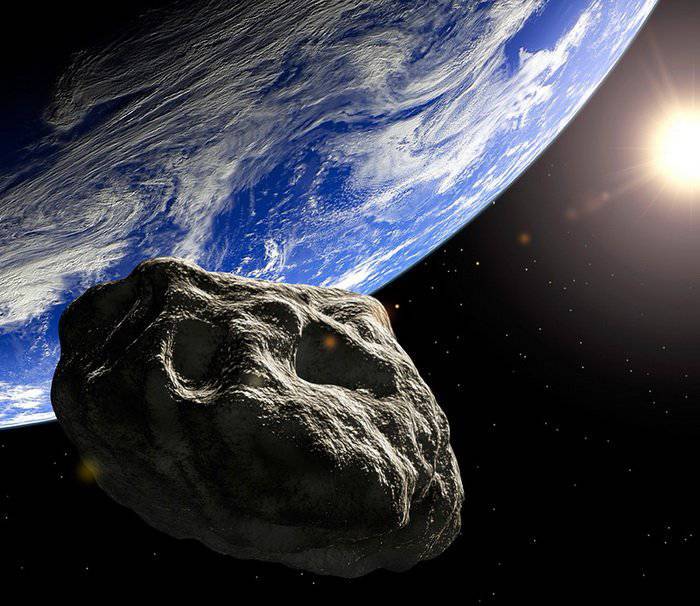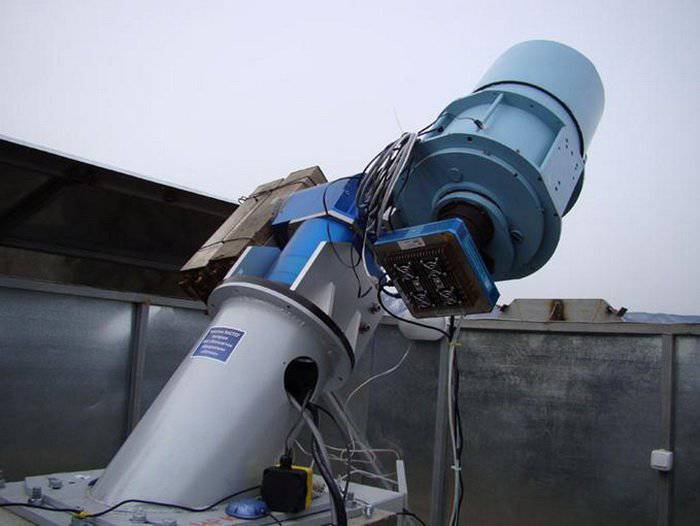The program to counter the cosmic threat can be implemented
The draft of the prepared target program is designed to protect Russia from meteorites. On the morning of February 15, residents of several regions of the Urals became unwitting witnesses of a global event. Residents of Chelyabinsk and neighboring areas first saw a huge glowing ball in the sky, which then broke up into several parts. Later, only traces of smoke remained in the sky, which looked like a plume from a flying airplane. A bright flash from the explosion was visible over the territory of the Chelyabinsk region, as well as over Yekaterinburg and Tyumen. Experts have estimated the power of the air explosion in 300-500 kilotons, and the shock wave formed after the explosion caused damage to thousands of buildings, many of which lost their glazing.
Only in Chelyabinsk, more than 1200 people turned to doctors with cuts and bruises, by a lucky chance this event went without victims.
According to Rykhlova, the fall of meteorites can be predicted if Russian scientists receive more telescopes. At present, we cannot foresee such situations, in particular, because in Russia at present there are almost no wide-angle and high-quality telescopes. The telescope installed at the Pulkovo Observatory functions on enthusiasm, absolutely outdated equipment is installed here, another telescope is being built in Irkutsk, but its construction lasts a very long time, Lydia Rykhlova noted.

According to Rykhlova, it is not enough just to find an asteroid, it must be studied. Small telescopes with special equipment may be engaged in the study task; they are still lacking in Russia. Our country occupies a very large area in longitude, so we need at least 3 wide-angle telescopes and some smaller for monitoring. At the same time, a single center is needed to collect and process incoming information. That is why today we face 3 tasks in order to create a Russian system for countering space threats: monitoring and detection, creating a single information and analytical center and creating a risk assessment system that will determine how dangerous the detected space object is to us.
The prepared document, which includes a detailed description of the components of this system, including space-based telescopes, has been located in Roscosmos since 2012, where it has already been approved. However, the total project costs at the level of 58 billion rubles (almost 2 billion dollars) for 10 years in Roscosmos were considered prohibitively high. According to Rykhlova, scientists were simply told that there is currently no such money. In turn, Andrei Ionin, a corresponding member of the Russian Academy of Cosmonautics, noted that he respects the position of Roscosmos, but it is not his task to decide whether to allocate funding or not. As we see today, meteorites pose a real threat to Russia and its citizens, while Roskosmos is solving other tasks and is not responsible for the safety of Russian citizens. In the case of Roskosmos, he had to go with the received document to the government if it was clear that his funds were insufficient for the implementation of such projects.
At present, work on such systems is quite actively carried out in the USA, the EU and, possibly, in the PRC. No one at the moment wants to depend on someone else’s information on dangerous space objects. In Russia, individual universities and observatories are working in this direction, but they are scattered and divided into small programs. The situation is aggravated by the fact that after the collapse of the Soviet Union, the country's best telescopes remained in places with the most transparent and clean air — in the mountains of Armenia and the republics of Central Asia.

Last Friday, Dmitry Rogozin tweeted on the need to develop a system for detecting space objects dangerous for the Earth. In this case, the Deputy Prime Minister cited the example of the United States and Australia, where there are programs for the early detection of asteroid danger. It is worth noting that Rogozin expressed a similar idea and 2 a year ago, as Russia's special representative for missile defense (PRO) - a system that is being created by the United States in Europe. At that time, Rogozin proposed to redirect efforts to missile defense to asteroids.
Currently, the Federal Targeted Program represented in Russia requires funding in 58 billion rubles, it is worth noting that this amount has already caused a mixed reaction in the society and the press. In particular, there are quite a few negative comments today, for example, that 58 billion rubles is 12 Phobos-Grunty or that currently the damage from the fall of the Chelyabinsk car is estimated at 1 billion rubles. program it will grow to 59 billion rubles. Lydia Rykhlova has already managed to respond to these claims, noting that at present there is a completely sick society in Russia: no one talks about cuts.
In an interview with the Gazeta.Ru edition, Rykhlova noted that the program was not developed yesterday, not after the fall of the meteorite to Chelyabinsk, but rather long ago. Work on it began in June 2010 of the year after the joint RAS Council on Space and the Roscosmos Presidium. Then the Russian scientists were told: “It is necessary to start creating a system for countering cosmic threats.” In the US, a similar service operates from the 1998 of the year, with its help they discover asteroids, including the well-known 2012 DA14, which flew at the shortest distance from the Earth. At the same time, in Russia, all information about asteroids is taken from this American system, since we do not have our own.

Initially, only asteroid-comet safety entered the Russian FTP, but a year later, according to Rykhlova, it was suggested that the program should be finalized, referring to man-made space debris. The developed target program for countering space threats provides for the modernization of small (mirror diameter up to 60 cm) institute and university telescopes in order to make them modern and can be used in these works. At the same time, the development of a number of wide-angle telescopes is necessary (the diameter of the mirror is about 2 m). The total sky is about 42 thousand square degrees. In order to monitor this entire area, Russia will need at least 3-x telescopes, which will need to be placed in different parts of the state, as the Russian Federation takes a lot of space in longitude.
The most important thing today is observation. The size of the meteorite, which fell in the Chelyabinsk region, was about 15 meters. On the one hand, this is a small celestial body, but on the other hand, it is the size of a typical five-story house. One can only imagine the consequences of what happened if the meteorite had not exploded in the sky, but had fallen on some of the cities. It is to prevent such cases in the future and necessary observations, while not only to determine the trajectory of a celestial body, but also its composition. All meteorites are different, among them there are stone, ice, iron, etc. In order to establish this, spectral and photometric observations of celestial objects are necessary.
At the same time, it is necessary to take into account the fact that ground-based telescopes are limited in their capabilities: the earth's atmosphere often hinders them, they can watch the sky at night, plus the light from modern large cities should be taken into account. Once the Pulkovo Observatory was far from Leningrad, today it is practically in the city and the starry sky is very hard to see from Pulkovo. The same situation with other telescopes, primarily institute ones. That is why the program involves launching space telescopes 1-2, so that they, when launched into near-earth orbit, are engaged in searching for dangerous objects using spectral and photometric methods. All this requires 58 billion rubles. At the same time, this program will help attract young people to science, improve the qualifications of existing Russian specialists.

Taking into account the fact that over the past 300 years, the statistics are maintained quite well, under the Chelyabinsk meteorite stories led to a massive injury of people (until now there was a 1-2 impact on a person without a fatal outcome, and as a result of the fall of the Chelyabinsk meteorite, more than 1000 people suffered). Therefore, the expenditure of such funds on astronomy, a warning system, tracking of cosmic bodies and warning people is justified.
Yes, we are not yet in a position to divert the cosmic threat from the planet, but we can warn the population about the danger. If astronomers had warned people about the fall of the Chelyabinsk meteorite in time, advised after a bright flash not to approach the windows, many would not have received bruises and cuts from broken glass and broken frames. The frames and windows would have suffered, but not the people, they would have managed to get by with a smaller number of wounded, therefore a warning system about the space threat must be created.
Information sources:
-http: //rus.ruvr.ru/2013_02_20/Kosmicheskij-monitoring-nebesnie-tela-vozmut-pod-kontrol
-http: //vpk.name/news/84771_fcp_byila_sdelana_ne_posle_padeniya_meteorita_a_uzhe_davno.html
-http: //www.fontanka.ru/2013/02/15/174
Information